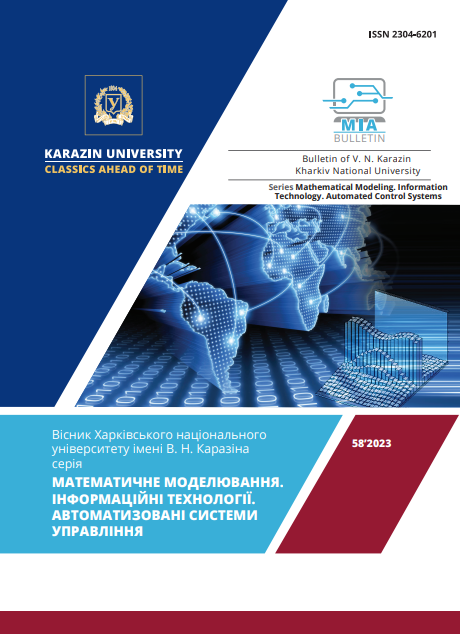Mathematical models and algorithms of computer modeling of spectrometric signals
Abstract
The technology of computer processing and analysis of data obtained in the process of measuring the energy spectra of X-ray and gamma radiation is gradually replacing the classic analog measurement methods. However, there is a problem of objective evaluation of the effectiveness of different computer analysis methods. Because obtaining reference data is not possible due to the randomness of processes during real experiments. A possible way to solve this problem is computer modeling of an artificial spectrometric signal with known parameters. This will provide an opportunity to determine the probability of detecting detector signals by different methods of mathematical and logical processing.
The purpose of this work is to develop mathematical models and algorithms for computer modeling of signals with known parameters and investigate the possibility of their use to evaluate the effectiveness of computer methods of recognition and analysis of these signals.
The article considers two different methods of synthesizing a digital image of a spectrometric signal with the required distribution of pulse amplitudes based on a preloaded template - a tabular function of amplitude distribution.
The first approach is based on the use of statistical methods and probability ranges for determining pulse amplitudes in the process of digital signal image creation. It allows you to simulate the process of the experiment, gradually forming a signal in which the distribution of amplitudes is always close to the given one. The basis of the second computer modeling approach is the use of deterministic final values of pulse amplitudes distribution in the generated signal. This approach makes it possible to obtain an accurate digital image of the signal with a random distribution of pulses in time, which does not contain statistical deviations from the template. But unlike the first, this method gives the required result only after the end of the entire session of computer modeling of the experiment.
The article presents some modeling results obtained during numerical experiments based on a computer program developed as a part of the research. When modeling by the first method using an experimentally obtained spectrum or an artificially created idealized template, it is shown that the resulting spectrum contains statistical deviations. But the amplitude distribution function generally corresponds to the tabular function specified in the template.
The described approaches and modeling algorithms can be used to create digital images of signals with fully defined input data to further test the effectiveness of computer-based methods of spectrometric signal parameters recognition and analysis.
Downloads
References
/References
W. Wolszczak, P. Dorenbos. Time-resolved gamma spectroscopy of single events. Nuclear Instruments and Methods in Physics Research. Section A: Accelerators Spectrometers Detectors and Associated Equipment. Volume 886. P. 30–55. 2018. URL: https://www.sciencedirect.com/science/article/abs/pii/S0168900217315036 (Last accessed: 28.12.2023)
Reva, S., & Tsybliyev, D. Computer methods of recognition and analysis of X-ray and gamma radiation parameters. Bulletin of V.N. Karazin Kharkiv National University, Series «Mathematical Modeling. Information Technology. Automated Control Systems». 2022. Volume 55. P. 38-48. https://periodicals.karazin.ua/mia/article/view/22593 (Last accessed: 28.12.2023) [in Ukrainian]
Averill M. Law, W. David Kelton. Simulation Modeling and Analysis. Third edition. McGraw-Hill. 760 pages. 2000.
Bjarne Stroustrup. The C++ Programming Language. Fourth Edition. Addison-Wesley. 2013. 1346 pages.
QT Framework Official Website. URL: https://www.qt.io/product/framework (Last accessed: 28.12.2023)
E.M. Khilkevitch, A.E. Shevelev, I.N. Chugunov, M.V. Iliasova, D.N. Doinikov, D.B. Gin, V.O. Naidenov, I.A. Polunovsky, Advanced algorithms for signal processing scintillation gamma ray detectors at high counting rates. Nuclear Instruments and Methods in Physics Research. Section A: Accelerators Spectrometers Detectors and Associated Equipment. Volume 997. 2020. URL: https://www.sciencedirect.com/science/article/abs/pii/S0168900220307051 (Last accessed: 28.12.2023)
A.E. Shevelev, et al., High performance gamma-ray spectrometer for runaway electron studies on the FT-2 tokamak, Nuclear Instruments and Methods in Physics Research. Section A: Accelerators Spectrometers Detectors and Associated Equipment. Volume 830. P. 102–108. 2016. URL: https://www.sciencedirect.com/science/article/abs/pii/S0168900216304685 (Last accessed: 25.12.2022)
Adam Drozdek. Data Structures and Algorithms in C++. Second Edition. Brooks/Cole. 2001. 650 pages.
I. V. Stetsenko. Systems modeling: textbook. Cherkasy: CSTU, 2010, 399 p. [in Ukrainian]
W. Wolszczak, P. Dorenbos. Time-resolved gamma spectroscopy of single events. Nuclear Instruments and Methods in Physics Research. Section A: Accelerators Spectrometers Detectors and Associated Equipment. 2018. Volume 886. P. 30–55. URL: https://www.sciencedirect.com/science/article/abs/pii/S0168900217315036 (дата звернення: 28.12.2023)
Рева С., Циблієв Д. Комп’ютерні методи розпізнавання та аналізу параметрів рентгенівського і гамма-випромінювання. Вісник Харківського національного університету імені В.Н. Каразіна, серія «Математичне моделювання. Інформаційні технології. Автоматизовані системи управління». 2022. Том 55, 38-48. URL: https://periodicals.karazin.ua/mia/article/view/22593 (дата звернення: 28.12.2023)
Averill M. Law, W. David Kelton. Simulation Modeling and Analysis. Third edition. McGraw-Hill. 2000. 760 pages.
Bjarne Stroustrup. The C++ Programming Language. Fourth Edition. Addison-Wesley. 2013. 1346 pages.
QT Framework Official Website. URL: https://www.qt.io/product/framework (дата звернення: 28.12.2023)
E.M. Khilkevitch, A.E. Shevelev, I.N. Chugunov, M.V. Iliasova, D.N. Doinikov, D.B. Gin, V.O. Naidenov, I.A. Polunovsky, Advanced algorithms for signal processing scintillation gamma ray detectors at high counting rates. Nuclear Instruments and Methods in Physics Research. Section A: Accelerators Spectrometers Detectors and Associated Equipment. 2020. Volume 997. URL: https://www.sciencedirect.com/science/article/abs/pii/S0168900220307051 (дата звернення: 28.12.2023)
A.E. Shevelev, et al., High performance gamma-ray spectrometer for runaway electron studies on the FT-2 tokamak, Nuclear Instruments and Methods in Physics Research. Section A: Accelerators Spectrometers Detectors and Associated Equipment. 2016. Volume 830. P. 102–108. URL: https://www.sciencedirect.com/science/article/abs/pii/S0168900216304685 (дата звернення: 28.12.2023)
Adam Drozdek. Data Structures and Algorithms in C++. Second Edition. Brooks/Cole. 2001. 650 pages.
Стеценко І.В. Моделювання систем: навчальний посібник. М-во освіти і науки України, Черкаський державний технологічний університет. Черкаси. 2010. 399 с.




